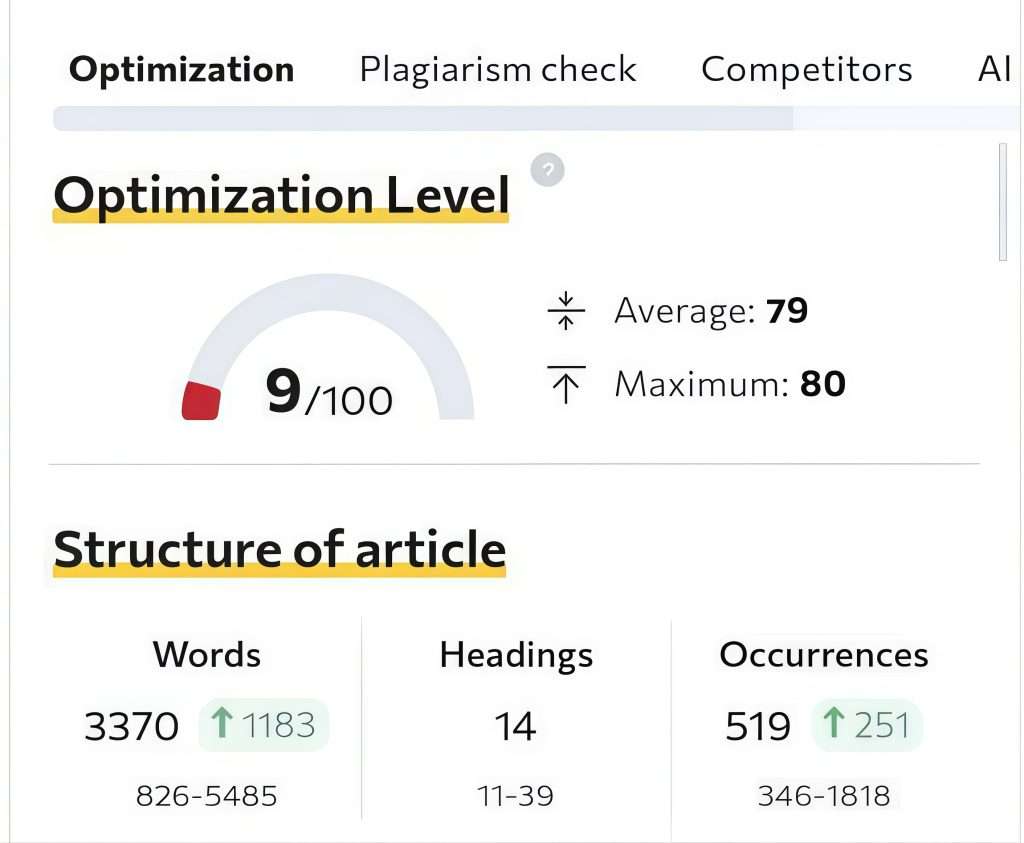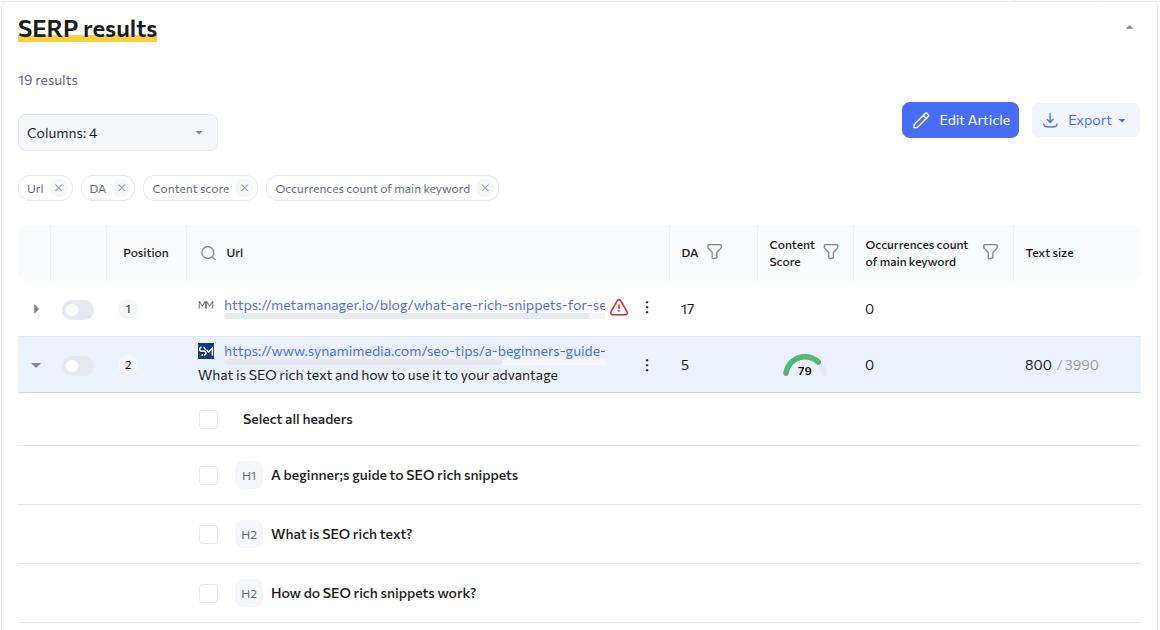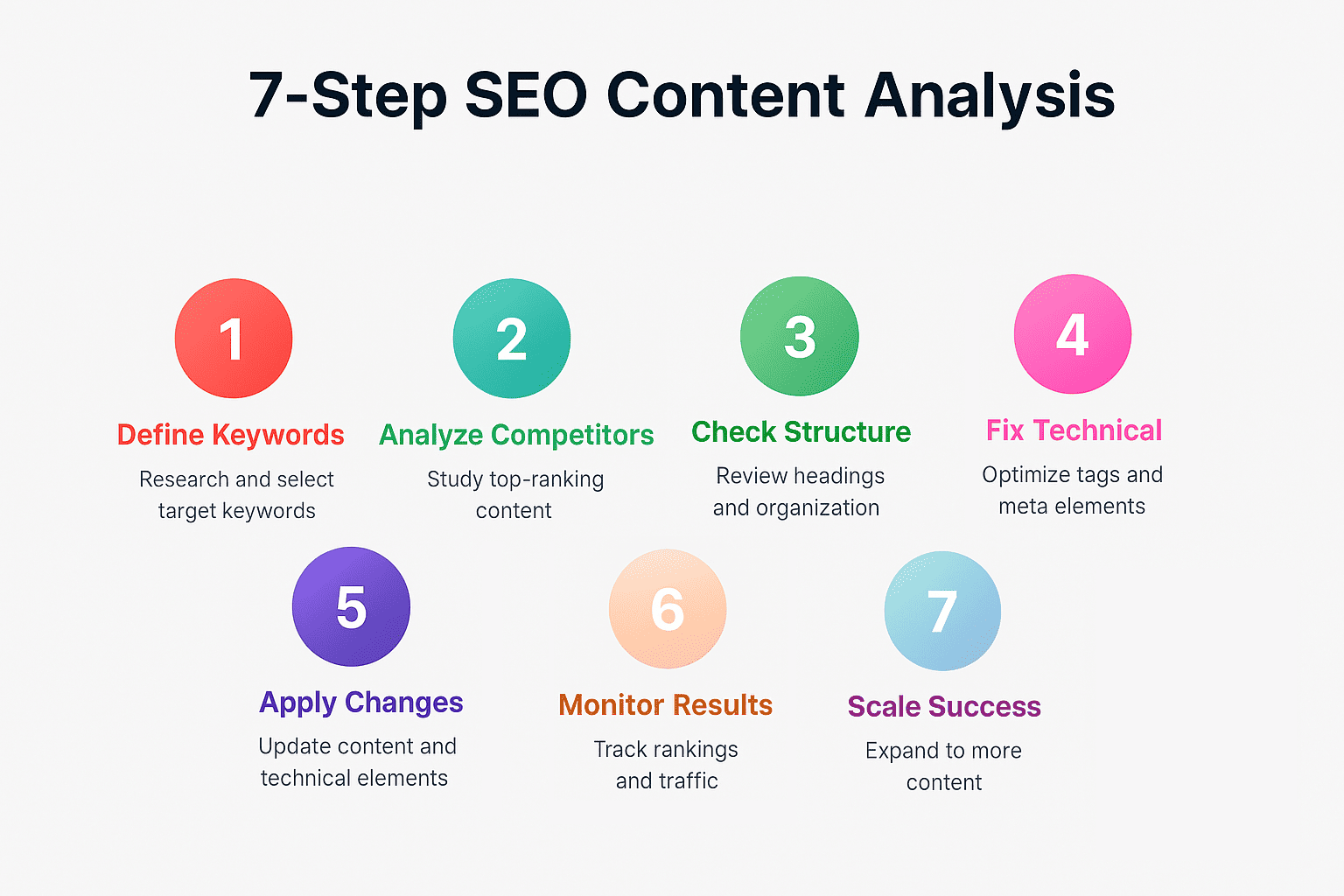What is SEO Content Analysis? The Complete Guide
You’ve spent hours crafting what you believe is exceptional content, only to discover it’s buried on page 10 of Google search results. This frustrating scenario happens because creating quality content and optimizing it for search engines are two entirely different challenges.
SEO content analysis is the systematic evaluation of your website content to identify factors that impact its organic search performance. This process helps you understand why your content isn’t ranking and provides a roadmap for improvement. Content analysis reveals the gap between your current performance and what search engines actually reward.
The content analysis process involves examining keyword usage, search intent alignment, content structure, and competitive positioning. By understanding these elements, you can transform underperforming content into traffic-generating assets that serve your target audience while satisfying search engine algorithms. This important aspect of SEO writing requires both technical knowledge and strategic thinking.
Key Takeaways
- SEO content analysis identifies optimization opportunities that significantly impact search rankings and organic traffic growth. Most websites struggle with content that doesn’t align with search intent, resulting in poor visibility despite quality content creation efforts.
- Content analysis tools streamline the evaluation process by providing data-driven insights on keyword usage, content gaps, and competitive positioning. These seo tools eliminate guesswork and provide actionable recommendations for improvement.
- Regular content analysis prevents common issues like keyword cannibalization, duplicate content, and search intent misalignment. Proactive analysis saves time and resources while maintaining competitive advantage in content marketing.
- Rush Analytics SEO Content Checker provides comprehensive analysis capabilities that help you identify and implement targeted improvements for better organic performance.
Common Problems with SEO Content
Here’s the strategic reality: most content fails to attract more traffic due to preventable issues. Understanding these problems is the first step toward creating content that actually ranks.
- Poor keyword targeting represents the most common content failure. You might target keywords that are either too competitive for your domain authority or completely irrelevant to your target audience.
- Search intent misalignment occurs when your content doesn’t match what users actually want when they search, affecting your focus keyword performance.
- Insufficient content depth prevents your pages from competing with comprehensive resources. When you create content that only scratches the surface of a topic, you’re essentially gifting rankings to competitors who provide more valuable insights.
- Poor technical structure lacking clear headings, logical flow, and appropriate sentence structure also impacts both user experience and search engine understanding.
When you analyze underperforming content, you’ll often discover it targets keywords that are either too competitive for your domain authority or completely irrelevant to your target audience. If someone searches “best project management software,” they want comparisons and recommendations—not a tutorial on project management principles.
SEO Analysis of Existing Assets
Your existing content represents untapped potential waiting to be optimized. Content analysis reveals four critical issues that prevent your pages from reaching their ranking potential and generating more traffic.
- Duplicate content creates internal competition and dilutes ranking power. When multiple pages target similar keywords or contain identical content blocks, search engines struggle to determine which web page deserves to rank. This confusion often results in none of your pages ranking well.
- Keyword cannibalization occurs when multiple pages compete for identical search terms, affecting your overall page seo performance.
- Content decay happens when previously successful content loses traffic over time due to changing algorithms or increased competition.
- Dropping click-through rates indicate content ranks but fails to attract clicks, often due to poor page title optimization.
As Google’s John Mueller states, “Title tags are an important way to communicate the main topic of your page to both users and search engines.”
The Rush Analytics SEO Content Checker simplifies this analysis by providing comprehensive data on all these potential problems, helping you prioritize which content needs immediate attention while identifying missing keywords and broken links.

Identifying Problems and Solutions
When you analyze your existing content, you’ll discover patterns that reveal systematic seo issues across your website. The SEO Content Checker identifies these problems through detailed analysis of your content’s performance metrics.
- Content uniqueness analysis reveals duplicate content by comparing your pages against each other and external sources. You’ll see exactly which content blocks are duplicated and how this impacts your search visibility, affecting your overall content score.
- Competing pages analysis shows you which of your pages target overlapping keywords and specific keywords. This feature helps you decide whether to consolidate content, differentiate targeting, or redirect pages to eliminate cannibalization.
- Content freshness tracking monitors how your content performs over time, alerting you when pages begin losing traffic or seo rankings. This proactive approach helps you address content decay before it significantly impacts your organic visibility.
- User engagement analysis examines metrics like click-through rates, bounce rates, and time on page to identify content that isn’t meeting user expectations. You can then optimize titles, meta descriptions, and content structure to improve engagement and conversion rate optimization.

SEO Analysis of New Content Ideas
Creating effective new content requires understanding what already performs well in search results. You can’t simply guess what will rank—you need data-driven insights about your competition and search landscape to improve rankings.
SERP analysis reveals patterns in top-ranking content that you can leverage for your own pages. When you analyze the first page of Google search results, you’ll discover common themes, content formats, and structural elements that search engines favor.
Competitive content analysis shows you exactly what your competitors are doing right. You’ll see their keyword usage, content depth, internal linking strategies, and technical optimizations that contribute to their rankings. This analysis helps content marketer professionals understand market positioning.
Content gap identification reveals topics and related keywords that your competitors cover but you don’t. These gaps represent opportunities to create content that can capture market share in your niche, especially for product pages and service offerings.
Search intent mapping helps you understand what users actually want when they search for your target keywords. This insight ensures your new content aligns with user expectations and search engine preferences, improving your word count efficiency.
The SEO Content Checker streamlines this analysis by automatically gathering data about top-ranking pages and presenting actionable insights for your content strategy.
How to Use SEO Content Checker for Analysis
The Rush Analytics SEO Content Checker transforms complex content analysis into a straightforward process that anyone can master. Here’s how you can leverage this powerful tool for comprehensive content evaluation.
- Content quality scoring provides an immediate assessment of your content’s optimization level. The tool analyzes your keyword usage, content depth, and structure to generate a score that indicates how well your content aligns with search engine preferences, similar to how the yoast seo plugin evaluates content.

- Keyword density analysis ensures you’re using your target keywords appropriately without over-optimization.
- Content depth evaluation compares your content length and comprehensiveness against top-ranking competitors, helping you understand optimal word count requirements.
- Technical SEO assessment reviews your meta tags, heading structure, and internal linking to identify technical issues that might prevent your content from ranking well.
- Competitor analysis shows you exactly what top-ranking pages are doing differently. You’ll see their keyword strategies, content structure, and optimization techniques that you can adapt for your own content brief development.

The tool analyzes your keyword usage, content depth, and structure to generate a score that indicates how well your content aligns with search engine preferences. You’ll see exactly how many times each keyword appears and receive recommendations for optimal usage, making it an essential part of any seo’s toolkit.
As Search Engine Land confirms, “Content optimization is the foundation of effective SEO strategy, requiring systematic analysis and strategic implementation.”
Comparison with Other Content Analysis Tools
While several content analysis tools exist in the market, choosing the right one depends on your specific needs, budget, and technical expertise. Understanding how different tools compare helps you make an informed decision for your content marketing strategy.
The following comparison highlights key differences between popular content analysis platforms:
- Clearscope offers robust content optimization features but comes with a higher price point
- Surfer SEO provides excellent content planning features with complex interface challenges
- Frase combines content research with optimization tools but requires significant learning curve
- MarketMuse delivers enterprise-level features with correspondingly high costs
Rush Analytics SEO Content Checker balances functionality, ease of use, and affordability. The tool provides comprehensive analysis capabilities without overwhelming users with unnecessary complexity. Its integration with other Rush Analytics tools creates a seamless workflow for complete SEO management.
The key differentiator is accessibility — while other tools require significant SEO expertise, the SEO Content Checker guides users through the optimization process with clear, actionable recommendations. This approach helps you analyze related topics and identify opportunities for content expansion.
Step-by-Step SEO Content Analysis Process
Effective content analysis follows a systematic approach that ensures you don’t miss critical optimization opportunities. This process works whether you’re analyzing existing content or planning new pieces for better seo rankings.
1. Define your target keywords
- Identify primary and secondary keywords for your content
- Research search volume and competition levels using keyword research tools
- Analyze search intent for each keyword and related topics
2. Analyze competitor content
- Review top 10 ranking pages for your target keywords
- Identify common content themes and structures
- Note keyword usage patterns and content depth
3. Evaluate content structure
- Review heading hierarchy and organization
- Analyze internal linking opportunities
- Assess content flow and readability using metrics like the gunning fog index
4. Optimize technical elements
- Review title tags and meta descriptions
- Analyze heading structure and keyword placement
- Evaluate image optimization and alt text
- Check xml sitemaps and technical SEO elements
5. Implement improvements
- Update content based on analysis findings
- Optimize technical elements for better visibility
- Monitor performance using Google Search Console
6. Track and refine
- Monitor organic traffic and search rankings
- Analyze user engagement metrics
- Schedule regular content analysis sessions
7. Scale optimization efforts
- Apply successful strategies to additional content
- Create systematic optimization workflows
The SEO Content Checker simplifies each step by providing automated analysis and specific recommendations for improvement.

Practical Recommendations for Implementing Analysis Results
Transforming analysis results into tangible improvements requires a strategic approach to implementation. Here’s how you can effectively apply your content analysis findings to improve rankings and drive more traffic.
Content optimization prioritization helps you focus on changes that will deliver the biggest impact. Start with technical fixes like title tags and meta descriptions, then move to content structural improvements, and finally address content depth and comprehensiveness.
Systematic content updates ensure you don’t miss important optimizations. Create a checklist based on your analysis findings and work through each item methodically. This approach prevents oversight and ensures consistent improvement across your content.
Performance monitoring tracks the impact of your optimizations through Google Analytics and search console data. Set up tracking for key metrics like organic traffic, search rankings, and user engagement to measure conversion rate optimization effectiveness.
Continuous improvement cycles maintain your content’s competitive edge. Schedule regular analysis sessions to identify new opportunities and address emerging issues. Content optimization isn’t a one-time activity—it’s an ongoing process that requires consistent attention.
As Google’s search quality guidelines emphasize, “Creating helpful, reliable, people-first content” should be your primary focus when implementing optimization strategies.
Conclusion
SEO content analysis transforms guesswork into strategic optimization that delivers measurable results. By systematically evaluating your content’s performance and competitive positioning, you can identify specific improvements that drive organic traffic and improve search rankings.
The key to successful content analysis lies in consistent application and data-driven decision making. Whether you’re optimizing existing content or planning new pieces, the insights from thorough analysis guide you toward content that both serves your target audience and satisfies search engine requirements.
Rush Analytics SEO Content Checker provides the tools and insights you need to implement effective content analysis strategies. With its comprehensive features and user-friendly interface, you can transform your content optimization process and achieve better organic search performance.
Try Rush Analytics SEO Content Checker
Get 7 days free trial access.
No credit card needed!

FAQs
What is the difference between SEO content analysis and SEO text analysis?
SEO content analysis evaluates comprehensive content strategy including structure, keywords, and user intent, while SEO text analysis focuses specifically on text elements like keyword density, readability, and grammar within the content itself.How often should I check my SEO content using a content checker tool?
You should analyze your content monthly for performance monitoring and quarterly for comprehensive audits. Additionally, analyze content immediately after Google algorithm updates or when you notice ranking changes.What metrics should a good content quality checker tool measure?
A comprehensive tool should measure keyword density, content depth, readability scores, search intent alignment, competitor analysis, technical SEO elements, and content uniqueness to provide complete optimization insights.How can I test my SEO content before publishing it?
Use content analysis tools to review keyword optimization, check search intent alignment, analyze competitor content, verify technical elements, and ensure content comprehensiveness before publication to maximize ranking potential.






